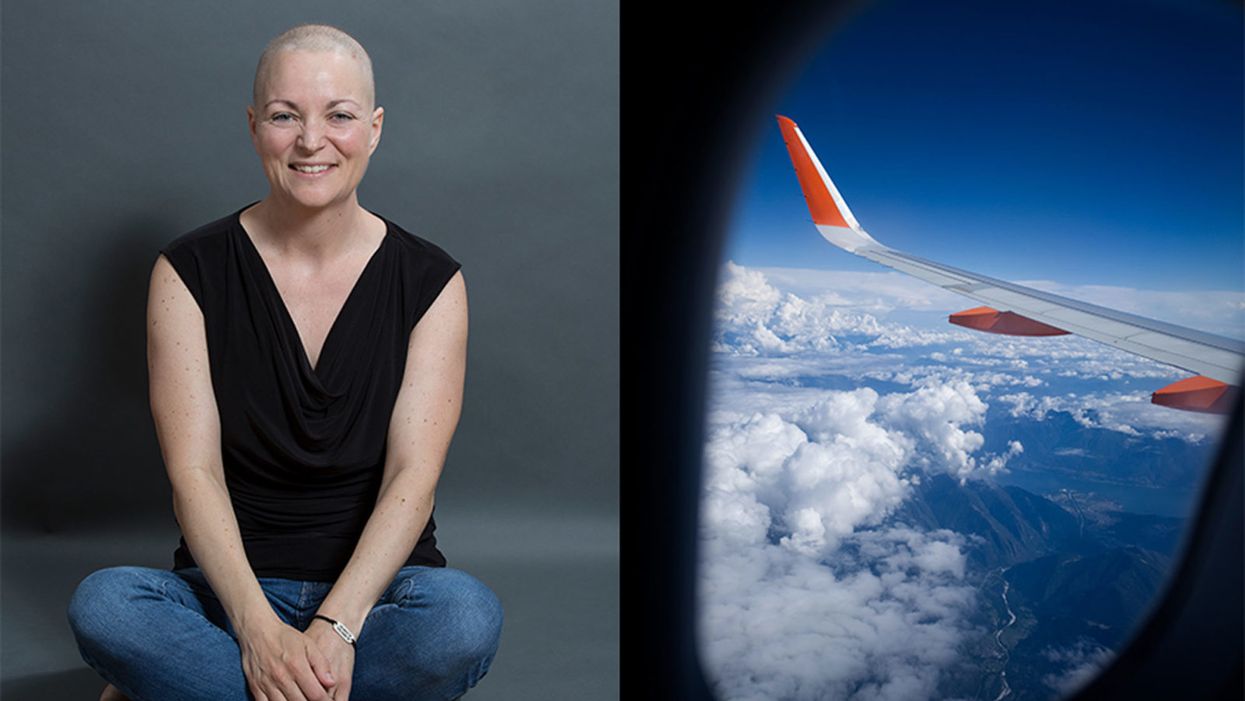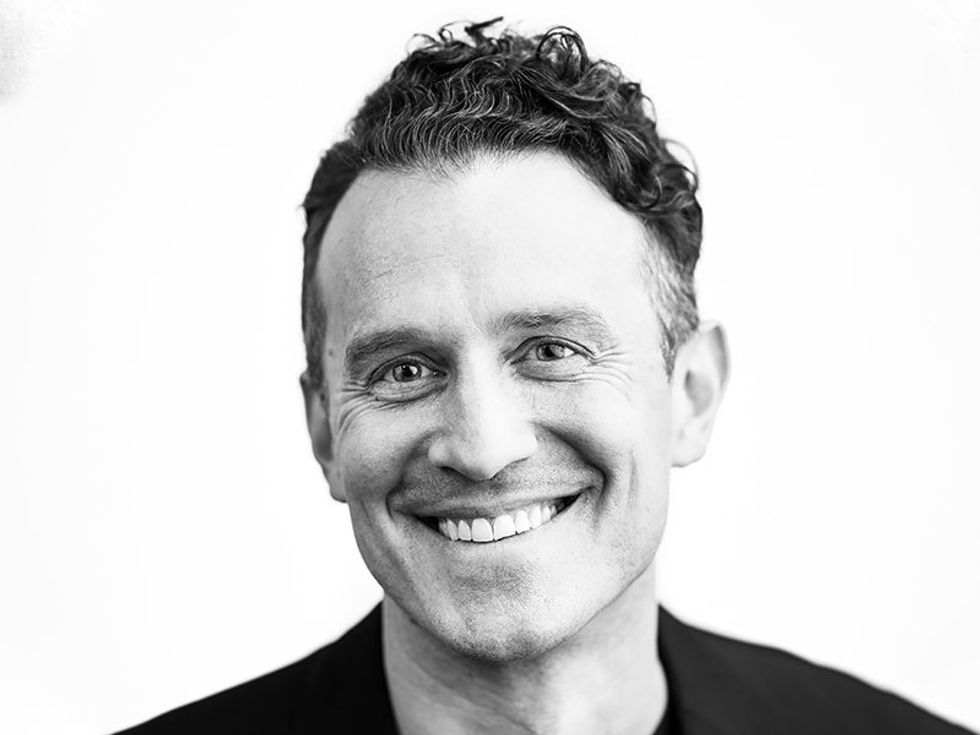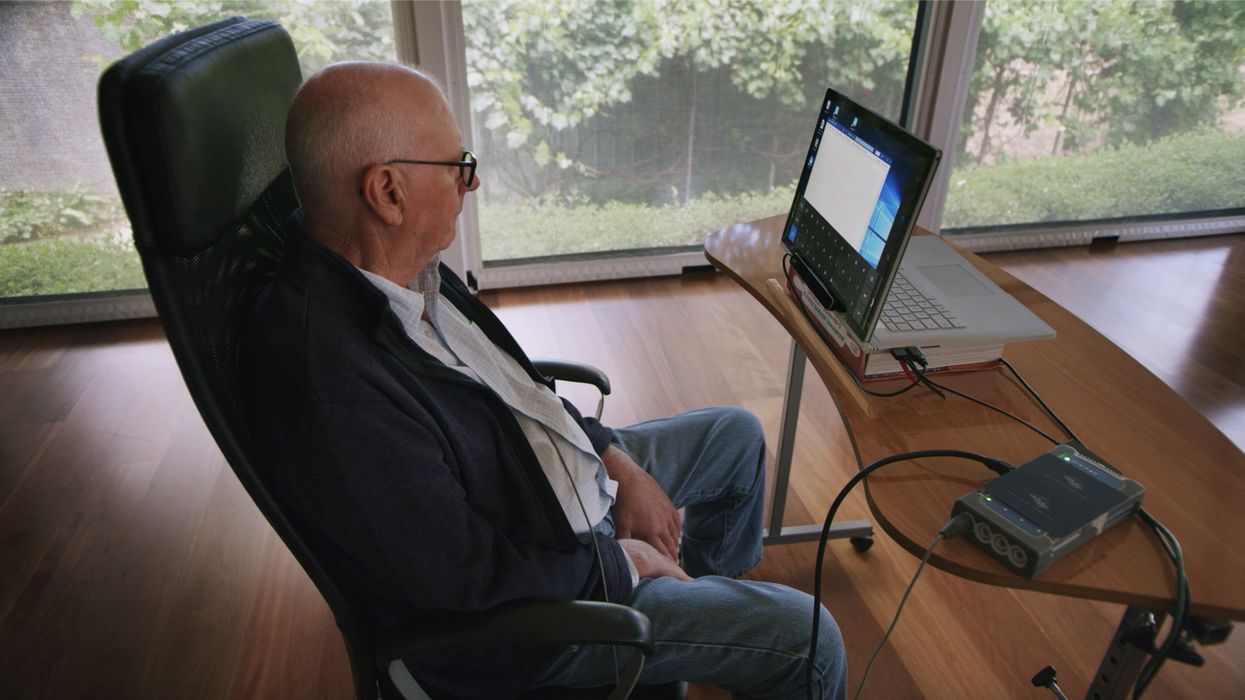Medical Tourism Is Booming, Fueled by High Costs and Slow Access

Bridget Snell traveled to Mexico to access an unapproved stem cell therapy for MS.
When Bridget Snell found out she had multiple sclerosis, she knew she would put up a fight. The 45 year-old mother of two, who lives in Duxbury, Mass., researched options to slow the progress of the disease. The methods she had been trying were invasive, often with side effects of their own.
An estimated 2.2 million Americans will travel abroad for medical care in 2020.
Then she stumbled upon autologous hematopoietic stem cell transplantation (AHSCT), an experimental and controversial procedure that uses the patient's own stem cells to try to halt the progress of the disease. The FDA has not approved this procedure and last year issued a warning about unapproved stem cell therapies.
Despite the lack of established science, Snell weighed her options and decided she would undergo the procedure at Clinica Ruiz, a private clinic in Puebla, Mexico, which boasts of the largest volume of cases in the world using the procedure to treat MS. In April 2018, she went to Mexico for treatment, returned home in a month, and continues to do well.
But a positive outcome is far from assured, says Sheldon Krimsky, adjunct professor in the Department of Public Health and Community Medicine at the Tufts School of Medicine.
"Often you can't get a good sense of what the quality of treatment is in another country," Krimsky says, adding that many companies promise procedures whose results have not been clinically validated. "Unfortunately, people are very easily persuaded by hope."
Traveling for Medical Care
Snell is one of many Americans who have traveled abroad to access medical care. Patients Beyond Borders, a medical tourism consultancy, estimates that 2.2 million Americans will do so in 2020. A 2018 BCC report projected a five-year compounded annual industry growth rate of 13.2 percent. Adding to the demand is the aging population, which is expected to reach 95 million people by 2060 – nearly double the number in 2018.
While Snell traveled to Mexico to try a procedure that was not yet available in the United States, other patients do so for a variety of reasons, primarily cost and speed of access. For example, despite having "pretty good insurance coverage," Washington resident Soniya Gadgil needed dental procedures that would have cost thousands of dollars out-of-pocket. An India native, she decided to travel to Pune, India to visit her parents -- and while there, she got the two root canals and implant that she needed. Gadgil saved 60 percent on the final bill.
Leaving the country for medical care is not restricted to dental work or FDA-banned procedures either. Patients visit countries around the world — South America, Central America, and the Caribbean top the list — for a number of other problems, such as knee and hip replacements and bariatric operations. The most common procedures sought abroad are for dentistry, cosmetic surgery, and cardiac conditions.
Traveling abroad to access less expensive procedures is a damning indictment of healthcare delivery in the United States, says Dr. Leigh Turner, associate professor at the Center for Bioethics at the University of Minnesota. "We have people who are being forced out of the system because of high costs. Collectively it suggests a real structural problem in terms of the organization of healthcare in the United States," Turner says.
The Growth of the Online Marketplace
Nevertheless, medical tourism is booming and a number of online businesses now meet patients' demand for discovery and facilitation of medical care abroad, like PlanMyMedicalTrip.com, Doctoorum.com, and Wellness Travels.
Anurav Rane, CEO and Founder of PlanMyMedicalTrip.com, says the company presents each potential client with options, a la Expedia. A knee replacement in India costs $2,500, a significantly cheaper option even with a $1,110 round-trip airfare from the United States, Rane says. The average cost for an inpatient total knee replacement in the United States in 2019 was a little more $30,000.
Once the client chooses a specific procedure at a specific hospital, the company facilitates the necessary groundwork including the medical visa, tickets, hotel stay, booking the procedure and pre and post-op stay, and consults with the surgeons or doctors even before arrival. "The hassle of planning is on us," Rane says. Once patients are settled in the accommodations, they undergo the procedure.
Playing in the Legal Shadows
The online marketplace companies and the medical team execute an orchestrated dance – but what happens if the patient is harmed during or after the procedure?
Turner says that medical malpractice, if it occurs, can be difficult to pursue abroad. "There are countries where the courts are notoriously slow and it's very difficult to get any kind of meaningful action and settlements," he says, even if the claims have a legitimate basis.
The industry's biggest challenge is trust.
Snell signed a waiver absolving her surgeons in Mexico of any legal claims. But, she points out, that's standard process even for procedures in the United States. "I signed just as many waivers as I would going into any surgery [in the US]."
While that might well be true, Turner argues, Americans don't waive legal rights when they sign consent forms. "There are some protections for patients here in the United States."
Beyond U.S. Medical Tourism
As expected, it's not just Americans who travel abroad for medical care. Lithuania-based Wellness Travels sees a significant percentage of its clients from the EU. PlanMyMedicaltrip.com has 15,000 surgeons and doctors from 12 countries in its database. Egypt-based Doctoorum works with professionals in its own country and attracts clients from the Middle East. It is looking to expand to include doctors from Jordan and India, among other countries.
The term "tourism" is misleading here because it muddies the picture about what post-op should really look like, says Gediminas Kondrackis of Wellness Travels. "Unfortunately a lot of medical travel facilitators mislead their clients by advertising beach holiday packages and the like. Post-op is really about quiet recovery inside for a few days; being out in the sun is not advisable."
The industry's biggest challenge is trust. "The dentist I went to is actually a friend of mine who has a successful practice for several years," says Gadgil, the Washington resident who had dental work done in India. "I'd hesitate to go to someone I don't know or to a place I have no experience with." Her apprehensions are not unusual. After all, anxiety is an expected reaction to any surgery. Word-of-mouth, cost savings, and thorough research may alleviate some of these trust issues.
"I had natural apprehensions and would have had them had I gone up the road to Brigham and Women's (in Boston) just as I did over the border," Snell says, "but I had done my homework extensively. That took a lot of the fear out of it."
Medical tourism will only increase, predicts Kondrackis. "There is still a lot of room to grow. Higher numbers of medical travelers could help reduce the strain on local healthcare systems by reducing wait times and controlling costs."
While patients who have benefited from medical tourism swear by it, the best cure would be to start at home by establishing healthcare equity, Krimsky says.
On the flip side, says Turner, it is debatable whether medical tourism actually benefits host countries, where local residents might get priced out of procedures at these exclusive clinics. Even if laws in host countries such as India might mandate "charity care" for poorer local patients, that does not always happen, Turner says. The trickle-down theory that these more expensive clinics will broaden access to care is often a pipe dream, he adds.
While patients who have benefited from medical tourism swear by it, the best cure would be to start at home by establishing healthcare equity, Krimsky says. "Now if we had universal healthcare in the United States," he adds, "that would be an entirely different story."
Or maybe not. Rane, of PlanMyMedicalTrip.com, has observed an influx of patients to India from Canada, a country with universal healthcare.
The reason they say they travel for care? Long wait times for procedures.
Scientists experiment with burning iron as a fuel source
Sparklers produce a beautiful display of light and heat by burning metal dust, which contains iron. The recent work of Canadian and Dutch researchers suggests we can use iron as a cheap, carbon-free fuel.
Story by Freethink
Try burning an iron metal ingot and you’ll have to wait a long time — but grind it into a powder and it will readily burst into flames. That’s how sparklers work: metal dust burning in a beautiful display of light and heat. But could we burn iron for more than fun? Could this simple material become a cheap, clean, carbon-free fuel?
In new experiments — conducted on rockets, in microgravity — Canadian and Dutch researchers are looking at ways of boosting the efficiency of burning iron, with a view to turning this abundant material — the fourth most common in the Earth’s crust, about about 5% of its mass — into an alternative energy source.
Iron as a fuel
Iron is abundantly available and cheap. More importantly, the byproduct of burning iron is rust (iron oxide), a solid material that is easy to collect and recycle. Neither burning iron nor converting its oxide back produces any carbon in the process.
Iron oxide is potentially renewable by reacting with electricity or hydrogen to become iron again.
Iron has a high energy density: it requires almost the same volume as gasoline to produce the same amount of energy. However, iron has poor specific energy: it’s a lot heavier than gas to produce the same amount of energy. (Think of picking up a jug of gasoline, and then imagine trying to pick up a similar sized chunk of iron.) Therefore, its weight is prohibitive for many applications. Burning iron to run a car isn’t very practical if the iron fuel weighs as much as the car itself.
In its powdered form, however, iron offers more promise as a high-density energy carrier or storage system. Iron-burning furnaces could provide direct heat for industry, home heating, or to generate electricity.
Plus, iron oxide is potentially renewable by reacting with electricity or hydrogen to become iron again (as long as you’ve got a source of clean electricity or green hydrogen). When there’s excess electricity available from renewables like solar and wind, for example, rust could be converted back into iron powder, and then burned on demand to release that energy again.
However, these methods of recycling rust are very energy intensive and inefficient, currently, so improvements to the efficiency of burning iron itself may be crucial to making such a circular system viable.
The science of discrete burning
Powdered particles have a high surface area to volume ratio, which means it is easier to ignite them. This is true for metals as well.
Under the right circumstances, powdered iron can burn in a manner known as discrete burning. In its most ideal form, the flame completely consumes one particle before the heat radiating from it combusts other particles in its vicinity. By studying this process, researchers can better understand and model how iron combusts, allowing them to design better iron-burning furnaces.
Discrete burning is difficult to achieve on Earth. Perfect discrete burning requires a specific particle density and oxygen concentration. When the particles are too close and compacted, the fire jumps to neighboring particles before fully consuming a particle, resulting in a more chaotic and less controlled burn.
Presently, the rate at which powdered iron particles burn or how they release heat in different conditions is poorly understood. This hinders the development of technologies to efficiently utilize iron as a large-scale fuel.
Burning metal in microgravity
In April, the European Space Agency (ESA) launched a suborbital “sounding” rocket, carrying three experimental setups. As the rocket traced its parabolic trajectory through the atmosphere, the experiments got a few minutes in free fall, simulating microgravity.
One of the experiments on this mission studied how iron powder burns in the absence of gravity.
In microgravity, particles float in a more uniformly distributed cloud. This allows researchers to model the flow of iron particles and how a flame propagates through a cloud of iron particles in different oxygen concentrations.
Existing fossil fuel power plants could potentially be retrofitted to run on iron fuel.
Insights into how flames propagate through iron powder under different conditions could help design much more efficient iron-burning furnaces.
Clean and carbon-free energy on Earth
Various businesses are looking at ways to incorporate iron fuels into their processes. In particular, it could serve as a cleaner way to supply industrial heat by burning iron to heat water.
For example, Dutch brewery Swinkels Family Brewers, in collaboration with the Eindhoven University of Technology, switched to iron fuel as the heat source to power its brewing process, accounting for 15 million glasses of beer annually. Dutch startup RIFT is running proof-of-concept iron fuel power plants in Helmond and Arnhem.
As researchers continue to improve the efficiency of burning iron, its applicability will extend to other use cases as well. But is the infrastructure in place for this transition?
Often, the transition to new energy sources is slowed by the need to create new infrastructure to utilize them. Fortunately, this isn’t the case with switching from fossil fuels to iron. Since the ideal temperature to burn iron is similar to that for hydrocarbons, existing fossil fuel power plants could potentially be retrofitted to run on iron fuel.
This article originally appeared on Freethink, home of the brightest minds and biggest ideas of all time.

How to Use Thoughts to Control Computers with Dr. Tom Oxley
Leaps.org talks with Dr. Tom Oxley, founding CEO of Synchron, a company that's taking a unique - and less invasive - approach to "brain-computer interfaces" for patients with ALS and other mobility challenges.
Tom Oxley is building what he calls a “natural highway into the brain” that lets people use their minds to control their phones and computers. The device, called the Stentrode, could improve the lives of hundreds of thousands of people living with spinal cord paralysis, ALS and other neurodegenerative diseases.
Leaps.org talked with Dr. Oxley for today’s podcast. A fascinating thing about the Stentrode is that it works very differently from other “brain computer interfaces” you may be familiar with, like Elon Musk’s Neuralink. Some BCIs are implanted by surgeons directly into a person’s brain, but the Stentrode is much less invasive. Dr. Oxley’s company, Synchron, opts for a “natural” approach, using stents in blood vessels to access the brain. This offers some major advantages to the handful of people who’ve already started to use the Stentrode.
The audio improves about 10 minutes into the episode. (There was a minor headset issue early on, but everything is audible throughout.) Dr. Oxley’s work creates game-changing opportunities for patients desperate for new options. His take on where we're headed with BCIs is must listening for anyone who cares about the future of health and technology.
Listen on Apple | Listen on Spotify | Listen on Stitcher | Listen on Amazon | Listen on Google
In our conversation, Dr. Oxley talks about “Bluetooth brain”; the critical role of AI in the present and future of BCIs; how BCIs compare to voice command technology; regulatory frameworks for revolutionary technologies; specific people with paralysis who’ve been able to regain some independence thanks to the Stentrode; what it means to be a neurointerventionist; how to scale BCIs for more people to use them; the risks of BCIs malfunctioning; organic implants; and how BCIs help us understand the brain, among other topics.
Dr. Oxley received his PhD in neuro engineering from the University of Melbourne in Australia. He is the founding CEO of Synchron and an associate professor and the head of the vascular bionics laboratory at the University of Melbourne. He’s also a clinical instructor in the Deepartment of Neurosurgery at Mount Sinai Hospital. Dr. Oxley has completed more than 1,600 endovascular neurosurgical procedures on patients, including people with aneurysms and strokes, and has authored over 100 peer reviewed articles.
Links:
Synchron website - https://synchron.com/
Assessment of Safety of a Fully Implanted Endovascular Brain-Computer Interface for Severe Paralysis in 4 Patients (paper co-authored by Tom Oxley) - https://jamanetwork.com/journals/jamaneurology/art...
More research related to Synchron's work - https://synchron.com/research
Tom Oxley on LinkedIn - https://www.linkedin.com/in/tomoxl
Tom Oxley on Twitter - https://twitter.com/tomoxl?lang=en
Tom Oxley TED - https://www.ted.com/talks/tom_oxley_a_brain_implant_that_turns_your_thoughts_into_text?language=en
Tom Oxley website - https://tomoxl.com/
Novel brain implant helps paralyzed woman speak using digital avatar - https://engineering.berkeley.edu/news/2023/08/novel-brain-implant-helps-paralyzed-woman-speak-using-a-digital-avatar/
Edward Chang lab - https://changlab.ucsf.edu/
BCIs convert brain activity into text at 62 words per minute - https://med.stanford.edu/neurosurgery/news/2023/he...
Leaps.org: The Mind-Blowing Promise of Neural Implants - https://leaps.org/the-mind-blowing-promise-of-neural-implants/

Tom Oxley

